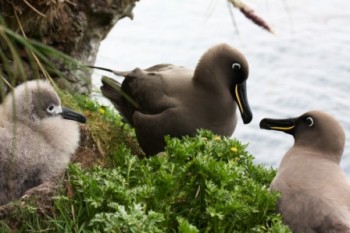In October 1982 I set up a small study of ACAP-listed Sooty Albatrosses Phoebetria fusca on Gough Island in the South Atlantic during the annual relief of the South African weather station. With colleagues at the University of Cape Town’s FitzPatrick Institute I colour- and metal-banded incubating birds along the coastal cliffs in Transvaal Bay near the weather station. The study continued annually until the 1989/90 season.
Because in those days there were no resident researchers on the island and volunteers on the weather team were not always willing to climb to exposed nests, information gathered was limited and the study was ended after eight years. We did learn, like elsewhere for this biennially-breeding species, that successful breeders take a year off. Breeding success varied quite a lot, but human disturbance from banding incubating birds causing nest desertions and egg losses affected the calculations.
With researchers now being present on the island year-round and with the Endangered albatross being an ACAP priority for investigation, the study was restarted after a long gap last year in much the same localities (click here).
With earlier relief voyages than hitherto it is now possible to restrict banding to the pre-laying period in September, essentially solving the problem of human-induced egg losses. Training in rope access and use of sit harnesses and fixed ropes has greatly reduced the risks of visiting the more exposed nests on the coastal cliffs.
Good then this year for me to find one of the colour-banded birds from my early study on a nest with its partner on 18 September. Because I was actually engaged in removing alien plants at the time I had no notebook with me so had to think of a way to remember the three-band colour code Blue Blue Green, hence “Bad Boy Gerald”. BBG was banded in October 1987 while incubating so must now be well over 26 years of age. It can be assumed it failed in the 1987/88 season as it was back incubating the next year.

Sooty Albatrosses on Gough's cliffs, photographed by Kalinka Rexer-Huber
As in all long-term demographic studies of seabirds the observer ages over the decades (my beard is white now, no longer the red of the 1980s) but the birds go on looking just the same. Must be a moral in this somewhere…
Research on ACAP-listed species on the outer islands of Tristan da Cunha is funded by the UK's Overseas Territories Environment Programme and the Darwin Initiative Programme via the Royal Society for the Protection of Birds and by the FitzPatrick Institute, University of Cape Town. It is conducted with the support and approval of the Tristan Conservation Department and the logistic support of the South African Department of Environmental Affairs.
John Cooper, ACAP Information Officer, on Gough Island, 24 September 2013

 English
English  Français
Français  Español
Español